How to get 99% less methane emissions from the slurry pit
Greenhouse gases act like a layer of window glass in the atmosphere: They prevent heat from being radiated from the Earth’s surface into space. Methane does that 28 times as effectively as carbon dioxide – it is (to stay in the picture) a kind of invisible double glazing.
Over the past 200 years, the concentration of methane in the atmosphere has more than doubled. This is mainly due to human meat consumption: For one thing, cows and other ruminants produce methane during digestion. Another important source is the excrement of the animals. One-third of the world’s man-made methane comes from livestock. It is estimated that up to 50 percent of it originates from fermentation processes in the slurry.
Researchers around the globe are therefore looking for ways to suppress these processes. A team of researchers has now presented 1 a promising solution to the problem. In the lab, they combined dairy cattle and fattening pig slurry from a farm with calcium cyanamide, a chemical that has been used as a fertilizer in agriculture for more than 100 years. This brought methane production to an almost complete halt.

A better fertilizer, with 99% less emissions
Overall, emissions fell by 99 percent. This effect started barely an hour after the addition and persisted until the end of the experiment half a year later. The long effectiveness is important, because slurry is not simply discarded. Rather, it is stored until the beginning of the following growing season and then spread on the fields as a valuable fertilizer. Months of storage are therefore quite common.
During this time, the slurry is transformed by bacteria and fungi: They break down undigested organic material into smaller and smaller molecules. Methane is produced at the end of these processes. Calcium cyanamide breaks this chain of chemical transformations, and does so simultaneously at different points, as the researchers were able to see in the chemical analysis of the slurry treated accordingly. The substance suppresses the microbial degradation of short-chain fatty acids, an intermediate in the chain, and their conversion to methane. Exactly how this happens is still unknown.
But the substance has other advantages as well: It enriches the slurry with nitrogen and thus improves its fertilizing effect. It also prevents the formation of so-called floating layers – these are deposits of organic matter that form a solid crust on the slurry and hinder gas exchange. This crust usually needs to be regularly broken up and stirred in.

The process also has advantages for the animals themselves: They are often kept on so-called slatted floors. Their excrement falls through openings in the floor into a large container. Microbial conversion allows the fecal-urine mixture to foam up over time and rise back up through the gaps. The animals are then standing in their own excrement. Calcium cyanamide stops this foaming. The costs are also manageable – they are calculated to represent around 0.3 to 0.5 cents per liter of milk for cattle farming.
Ammonia problem instead of a methane problem?
It is still unclear how the method affects the release of ammonia from the slurry, though. Ammonia is a toxic gas that, while not harmful to the climate itself, can be converted to dangerous greenhouse gases. There are initial indications that the amount of ammonia is also reduced in the long term, but available data are not conclusive.
References
- Felix Holtkamp, Joachim Clemens & Manfred Trimborn (2023) Calcium cyanamide reduces methane and other trace gases during long-term storage of dairy cattle and fattening pig slurry Waste Management doi: 10.1016/j.wasman.2023.02.018 ↩